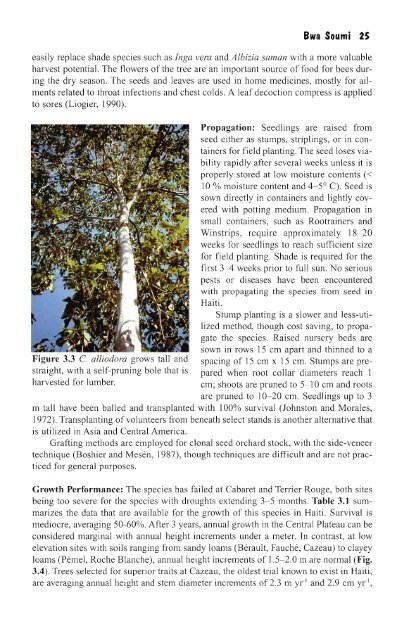Important Trees of Haiti
Important Trees of Haiti
Important Trees of Haiti
Create successful ePaper yourself
Turn your PDF publications into a flip-book with our unique Google optimized e-Paper software.
Figure 3.3 C. alliodora grows tall and<br />
straight, with a self-pruning bole that is<br />
harvested for lumber.<br />
Bwa Soumi 25<br />
easily replace shade species such as Inga vera and Albizia saman with a more valuable<br />
harvest potential. The flowers <strong>of</strong> the tree are an important source <strong>of</strong> food for bees during<br />
the dry season. The seeds and leaves are used in home medicines, mostly for ailments<br />
related to throat infections and chest colds. A leaf decoction compress is applied<br />
to sores (Liogier, 1990).<br />
Propagation: Seedlings are raised from<br />
seed either as stumps, striplings, or in containers<br />
for field planting. The seed loses viability<br />
rapidly after several weeks unless it is<br />
properly stored at low moisture contents «<br />
10 % moisture content and 4-5 0 C). Seed is<br />
sown directly in containers and lightly covered<br />
with potting medium. Propagation in<br />
small containers, such as Rootrainers and<br />
Winstrips, require approximately 18-20<br />
weeks for seedlings to reach sufficient size<br />
for field planting. Shade is required for the<br />
first 3--4 weeks prior to full sun. No serious<br />
pests or diseases have been encountered<br />
with propagating the species from seed in<br />
<strong>Haiti</strong>.<br />
Stump planting is a slower and less-utilized<br />
method, though cost saving, to propagate<br />
the species. Raised nursery beds are<br />
sown in rows 15 cm apart and thinned to a<br />
spacing <strong>of</strong> 15 cm x 15 cm. Stumps are prepared<br />
when root collar diameters reach 1<br />
cm; shoots are pruned to 5-10 cm and roots<br />
are pruned to 10-20 cm. Seedlings up to 3<br />
m tall have been balled and transplanted with 100% survival (Johnston and Morales,<br />
1972). Transplanting <strong>of</strong> volunteers from beneath select stands is another alternative that<br />
is utilized in Asia and Central America.<br />
Grafting methods are employed for clonal seed orchard stock:, with the side-veneer<br />
technique (Boshier and Mesen, 1987), though techniques are difficult and are not practiced<br />
for general purposes.<br />
Growth Performance: The species has failed at Cabaret and Terrier Rouge, both sites<br />
being too severe for the species with droughts extending 3-5 months. Table 3.1 summarizes<br />
the data that are available for the growth <strong>of</strong> this species in <strong>Haiti</strong>. Survival is<br />
mediocre, averaging 50-60%. After 3 years, annual growth in the Central Plateau can be<br />
considered marginal with annual height increments under a meter. In contrast, at low<br />
elevation sites with soils ranging from sandy loams (Berault, Fauche, Cazeau) to clayey<br />
loams (Pemel, Roche Blanche), annual height increments <strong>of</strong> 1.5-2.0 m are normal (Fig.<br />
3.4). <strong>Trees</strong> selected for superior traits at Cazeau, the oldest trial known to exist in <strong>Haiti</strong>,<br />
are averaging annual height and stem diameter increments <strong>of</strong> 2.3 m yr- I and 2.9 cm yr- I ,

















